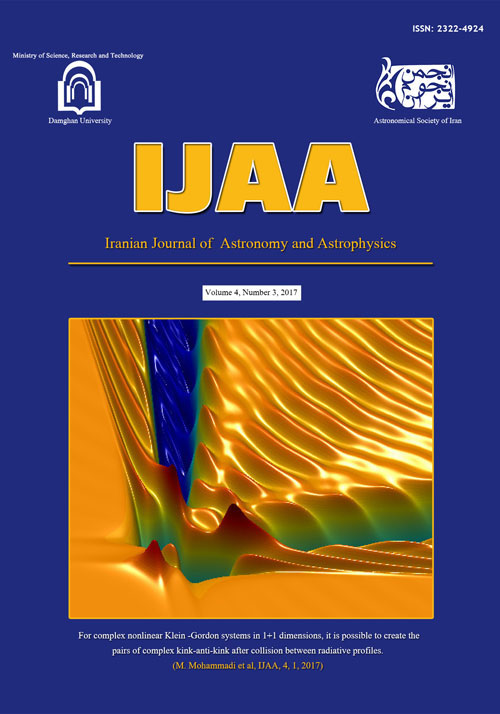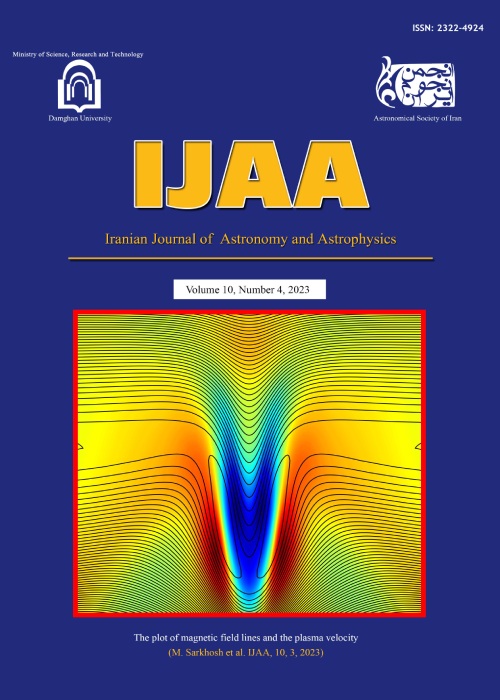فهرست مطالب

Iranian Journal of Astronomy and Astrophysic
Volume:5 Issue: 2, Autumn 2018
- تاریخ انتشار: 1397/07/09
- تعداد عناوین: 6
-
-
Pages 63-74
The characteristics of arbitrary amplitude dust ion acoustic solitary waves (DIASWs) are studied in unmagnetized dusty plasmas whose constituents are cold uid ions, nonextensive electrons and stationary negative/positive dust particles. The pseudopotential approach has been used to investigate the structure of localized waves. It is found that, solitary waves exist in a definite interval for the Mach number which depends sensitively to the electron nonextensivity and dust polarity. Our results can be useful to understand the properties of localized electrostatic disturbances that may occur in astrophysical and space dusty plasmas.
Keywords: Dust Ion Acoustic Soliton, Sagdeev Potential, Nonextensive Electrons, Dust Polarity -
Pages 75-82Solar coronal loops represent variety of fast, intermediate, and slow normal mode oscillations. In this study, the transverse oscillations of a coronal loop observed on 11 October, 2013 are analyzed using the Extreme Ultra-Violet (EUV) images of the Sun. Employing the 171 AA solar images recorded by the Solar Dynamic Observatory (SDO)/Atmospheric Imaging Assembly (AIA), we extracted the oscillation parameters such as period, damping time, loop length, and the loop width. The period and the damping of this loop are obtained to be 19 ± 1 and 70 ± 1 minutes, respectively. Also, the damping quality, the ratio of the damping time to the period, is obtained to be 3.6. Therefore, we conclude that the damping of the transverse oscillation of this loop is in the strong damping regime. It is suggested that the resonant absorption would be a well suitable candidate for the damping mechanism of the studied loop.Keywords: Sun, corona, loop, oscillations
-
Pages 83-98In this paper, we obtain a new class of $(n+1)$-dimensional magnetic brane solutions of quasi-topological gravity in the presence of exponential and logarithmic nonlinear electrodynamics by a spinning magnetic branes with one or more rotation parameters. For the spinning brane, the brane has a net electric charge, when one or more rotation are non zero, and also this electric charge is proportional to the magnitude of the rotation parameter. However, when all the rotation parameters are zero (static brane), the electric field vanishes and the brane has no net electric charge. In the class of solutions, we have a spacetime with an angular magnetic field. These solutions are horizonless and have no curvature, but there is a conic singularity with a deficit angle. In addition, these two forms of nonlinear electrodynamics theory, have the same behaviors for the obtained solutions. Finally, we use the counterterm method and compute conserved quantities of these spacetimes.Keywords: Quasi-topological gravity, rotating magnetic brane, Thermal stability
-
Pages 99-104In this paper, we investigate geometric quantization of massive superparticles in four dimensional space-time, which preserves $frac{1}{4}$ of the target space supersymmetry. Because the black holes (also massive black holes) are strong gravitational system, hence, application of such quantization to the supersymmetric cosmological blackholes would give us information about quantum gravity. As such supermassive black holes are candidate of dark matter hence our calculations are important from cosmological point of view. The world-line action of this model contains a Wess-Zumino term which breaks $d=4$ Lorentz symmetry. We solve Hamiltonian equation and obtain unique solution, which help to calculate prequantization operator. It yields to corresponding Dirac equationwhich is important in relativistic quantum mechanics. It will be useful in the second quantization of the same models. On the other hand superparticles are itself candidate of dark matter and dark matter are important from their gravitation effects, hence their quantization may yields to quantum gravity theory.Keywords: Cosmological black hole, Geometric quantization, Quantum Mechanics, Superparticle
-
Pages 105-115In the present work, we studied the α- 4He particle elastic scattering by measuring cross section with halo Effective Field Theory (hEFT) at low energies. In this article, we considered α- 4He elastic scattering in S-wave state at the very low energy. The α- 4He elastic scattering amplitude comprises the initial s-wave strong and Coulomb interaction at leading order. Because of the unnaturally large scattering length of the aαα, it is considered as a halo system. We defined the lagrangian of this system and then calculated the T-matrix for the scattering amplitude at leading order by using of the Feynman diagrams. Data of the α- 4He elastic scattering refer basically to the low energy extending to 0.29 MeV, the total cross section that with this approach has been calculated will be σ_t≃ 16:0226 mb. It was shown that, the presented strategy can be efficiently developed for the other halo nucleus.Keywords: Elastic Scattering, T-matrix, Cross Section, halo Effective Field Theory
-
Pages 117-123
The study of the thermodynamics of relativistic fluid is important in astrophysics and modern physics. In this paper, we calculate two important parameters of the special relativistic fluids which are the viscous stress and heat flux tensors in the Cartesian coordinate system. We calculated the explicit relations of viscous stress tensor with velocity, spatial and time derivative of velocity. Also, the relation of heat flux tensor is derived with velocity, temperature and spatial and time derivatives of them. The components of viscous stress and heat flux tensors in the other coordinates can be derived by the transformation matrix. We use the relativistic method for deriving the non-relativistic viscous stress and heat flux tensors in the limit of the relativistic method. So, to improve the accuracy of non-relativistic studies of shear rate, viscous stress tensor, heat flux vector, and heat flux tensor, especially in the fast fluids, the special relativistic corrections can be used.
Keywords: Special relativistic viscosity, Special relativistic heat flux, Special relativistic fluids


